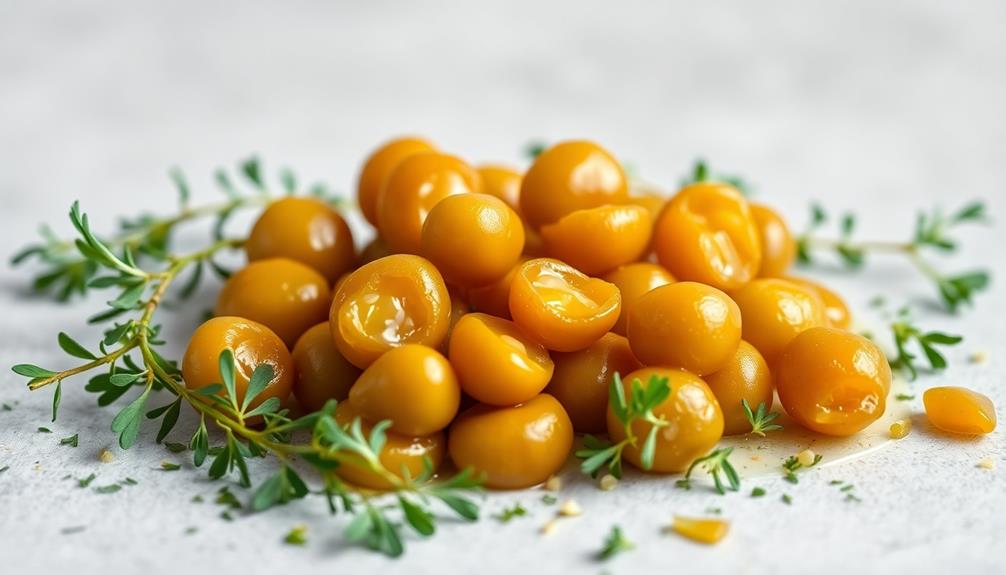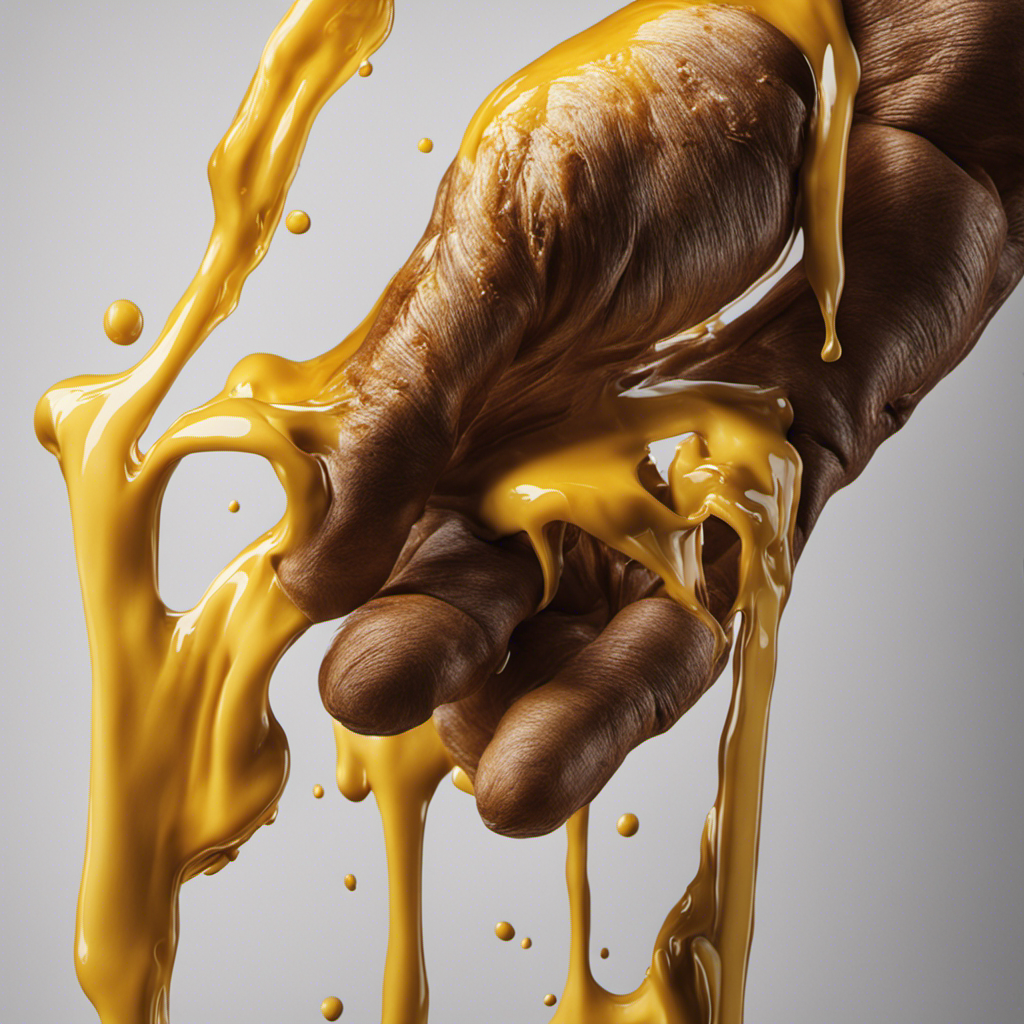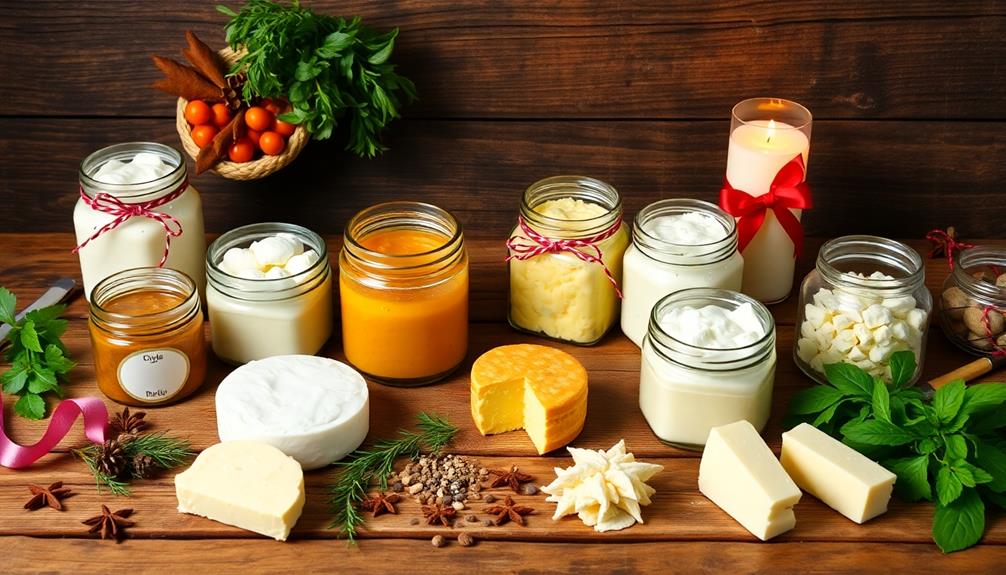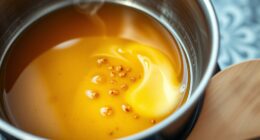Were you aware that butter is prone to burning when exposed to high heat? Indeed, it’s essential to comprehend the precise temperature at which butter starts to burn to ensure optimal cooking outcomes.
In this article, I will delve into the science behind butter burning, explore the factors that affect its burning point, and provide valuable tips on how to prevent butter from burning.
So, if you want to elevate your cooking skills and avoid any burnt butter mishaps, keep reading!
Key Takeaways
- Butter burns at high temperatures, typically around 350°F (175°C).
- The burning of butter is caused by the browning of milk solids during the Maillard reaction.
- The burning point of butter can be influenced by factors such as the heat source, thickness of butter, presence of impurities, and composition of butter.
- To prevent butter from burning, it is recommended to adjust the heat, use clarified butter or high smoke point oils, and constantly stir the butter while melting.
The Science Behind Butter Burning
Butter burns when it reaches a high temperature. Understanding the thermal properties of butter can help explain this phenomenon.
Butter is composed of fat, water, and milk solids. When heated, the water in butter evaporates, causing the temperature to rise. At around 350°F (175°C), the milk solids in butter begin to brown, giving it a rich and nutty flavor. This process is known as the Maillard reaction.
However, if the heat is not controlled, the milk solids can burn, resulting in a bitter taste and the release of smoke. Several factors can affect the burning point of butter, such as the type of heat source, the thickness of the butter, and the presence of impurities.
Understanding these factors can help prevent butter from burning and ensure optimal cooking results.
Factors Affecting Butter’s Burning Point
When discussing the factors affecting butter’s burning point, it’s important to consider the relationship between heat and butter composition.
The composition of butter, which includes milk fat, water, and milk solids, can greatly influence its reaction to high temperatures.
Additionally, understanding the smoke point of butter is crucial in determining its suitability for different cooking methods and recipes.
Heat and Butter Composition
As it heats up, butter can undergo a chemical change due to its composition. Butter is a mixture of fat, water, and milk solids, which makes it a complex substance with unique properties. One important characteristic of butter is its heat conductivity, which affects how it reacts to temperature changes.
Butter has a relatively low melting point, around 32 to 35 degrees Celsius (90 to 95 degrees Fahrenheit), which means it can easily melt when exposed to heat. The heat conductivity of butter allows it to distribute heat evenly, making it useful for cooking and baking.
However, as the temperature continues to rise, butter can reach its smoke point, which is the topic we will explore next.
TRANSITION: Now that we understand how heat affects the composition of butter, let’s explore the concept of butter’s smoke point.
Butter’s Smoke Point
Once heated to a certain point, butter releases a white smoke and develops a unique flavor. This point is known as the butter’s smoke point, and it is an important factor to consider when cooking with butter. Understanding the smoke point of butter can help us prevent burning and achieve the desired flavor in our dishes.
Here are three key things to understand about butter’s smoke point:
- Butter has a lower smoke point compared to other oils and fats.
- The smoke point of butter can vary depending on its composition and quality.
- When butter reaches its smoke point, it breaks down and undergoes chemical changes that result in the release of flavorful compounds.
Understanding Smoke Points for Butter
To understand the smoke point for butter, you should know that it is the temperature at which it starts to produce smoke. Through various butter burning experiments, researchers have determined that the smoke point of butter is around 350°F (177°C).
This means that when butter is heated beyond this temperature, it begins to break down and release smoke. However, it is important to note that the best temperature for browning butter is slightly lower, around 300°F (149°C). At this temperature, butter undergoes a process called the Maillard reaction, resulting in a rich, nutty flavor and aroma.
Transitioning into the next section, it is crucial to understand that as butter is exposed to higher temperatures, its flavor profile undergoes significant changes.
Butter’s Flavour Changes at High Temperatures
When it comes to the taste of butter, there are a few factors to consider.
First, the taste threshold of butter refers to the point at which we can detect its flavor.
Second, chemical reactions occur in butter when exposed to high temperatures, leading to changes in taste and aroma.
Lastly, butter has a smoke point, which is the temperature at which it starts to burn and release smoke.
Understanding these key points can help us better appreciate the flavor and cooking properties of butter.
Butter’s Taste Threshold
If you heat butter beyond its taste threshold, it will start to burn and develop a bitter taste. This occurs because the milk solids in butter begin to break down and undergo a process called caramelization, resulting in the formation of compounds that contribute to the bitter flavor.
However, it’s important to note that the taste threshold of butter can vary depending on factors such as the type of butter and its moisture content.
Here are some key points to consider regarding butter’s taste threshold:
-
Butter’s aroma: As butter heats up, it releases a distinct aroma due to the evaporation of volatile compounds. This aroma can enhance the overall sensory experience of dishes.
-
Butter’s browning potential: Butter has a high browning potential, meaning it can undergo Maillard reactions at relatively low temperatures. This browning adds depth and complexity to dishes.
-
Monitoring heat: To prevent butter from burning, it is crucial to monitor the heat carefully. Use low to medium heat and avoid leaving butter unattended on a hot surface.
Understanding the taste threshold of butter is essential for achieving desired flavors and avoiding unpleasant bitterness.
Chemical Reactions in Butter
Chemical reactions occur in butter when it is heated beyond its taste threshold, resulting in the development of a bitter taste. This is due to the process of butter oxidation, which leads to the formation of compounds that contribute to the bitter flavor. One of the main reactions involved in this process is the browning of butter. When butter is heated, the milk solids and sugars present in it undergo a series of chemical reactions known as the Maillard reaction. This reaction causes the butter to brown and develop a rich, nutty flavor. However, if the butter is heated for too long or at too high a temperature, the Maillard reaction can go too far and result in the production of bitter compounds. It is important to monitor the temperature carefully to prevent butter from burning and acquiring an unpleasant taste.
| Reaction | Temperature Range (°C) | Result |
|---|---|---|
| Butter Oxidation | 60-120 | Bitter Taste |
| Butter Browning | 130-180 | Rich, Nutty Flavor |
Butter’s Smoke Point?
The smoke point of butter determines the maximum temperature at which it can be heated without releasing smoke. When butter is heated beyond its smoke point, it undergoes a series of chemical reactions that result in the release of smoke. This smoke is not only undesirable but can also affect the flavor of the dish being prepared.
Understanding butter’s smoke point is crucial in cooking, as it allows us to prevent burning and maintain the quality of our dishes. Here are some key points to consider:
- Different types of butter have different smoke points, with clarified butter having a higher smoke point than regular butter.
- As butter is heated, its flavor changes, developing a nutty and caramelized taste.
- Heating butter beyond its smoke point can result in a burnt, bitter flavor.
Knowing the smoke point of butter and how it affects flavor allows us to take necessary precautions to prevent burning and maintain the desired taste in our dishes.
How to Prevent Butter From Burning
To prevent butter from burning, you can adjust the heat on the stove. The key is to keep the temperature low and steady. Butter has a low smoke point, around 350°F (175°C), which means it can easily burn if the heat is too high.
One alternative to prevent butter burning is to use clarified butter or ghee. These have a higher smoke point, usually around 450°F (232°C).
Another option is to mix the butter with a high smoke point oil, such as canola or vegetable oil. This will raise the overall smoke point of the mixture, making it less likely to burn.
Additionally, using a non-stick pan can help prevent burning as it reduces the likelihood of the butter sticking to the surface.
Taking these precautions will ensure that your butter remains golden and flavorful, without the risk of burning.
Recipes That Require Butter Burning
When it comes to butter burning techniques, there are several methods that can be employed to achieve the desired result. From using high heat to quickly brown the butter to slowly simmering it to create a nutty flavor, each technique offers a unique outcome.
Additionally, alternative ingredients can be used in place of butter to achieve a similar effect, such as ghee or coconut oil. However, it is important to note that there are risks associated with burning butter, including the release of harmful compounds and the potential for a burnt taste in the final dish.
Butter Burning Techniques
Butter burns easily if heated too quickly. To prevent this, it is important to use the right techniques. Here are some effective methods:
-
Low Heat: Heating butter over low heat allows for a slow and controlled melting process, reducing the risk of burning.
-
Constant Stirring: Continuously stirring the butter while it melts helps distribute the heat evenly and prevents it from overheating.
-
Clarifying: Clarifying butter involves removing the milk solids, which have a lower smoke point than the pure fat. This results in a higher smoke point and reduces the chances of burning.
When it comes to alternative ingredients for burning butter, there are a few options available. Ghee, also known as clarified butter, has a higher smoke point and can be used as a substitute. Other alternatives include coconut oil and vegetable shortening, which have higher smoke points and can withstand higher temperatures without burning.
Alternative Ingredients for Burning Butter
If you’re looking for alternatives to burning butter, consider using ghee, coconut oil, or vegetable shortening. These ingredients can be excellent substitutes for high heat cooking, providing a similar flavor and texture to butter without the risk of burning. To help you make an informed decision, here’s a table comparing these alternative ingredients based on their smoke points, flavor profiles, and availability:
| Ingredient | Smoke Point | Flavor Profile | Availability |
|---|---|---|---|
| Ghee | 450°F | Rich and nutty | Widely available |
| Coconut Oil | 350°F | Mildly sweet | Widely available |
| Vegetable Shortening | 360°F | Neutral | Widely available |
As you can see, all three alternatives have high smoke points, making them suitable for browning and high heat cooking. They also offer distinct flavor profiles that can enhance your dishes. Now, let’s explore the risks of burning butter in the next section.
Risks of Burning Butter
To avoid the risks of burning, you should pay close attention to the cooking process and adjust the heat accordingly. Burning butter can lead to a variety of problems, including a bitter taste, the release of harmful compounds, and the potential for a kitchen fire. It is important to monitor the temperature of the butter to prevent overheating.
Here are some key risks of overheating butter:
- Bitter taste: When butter is overheated, it can develop a burnt or bitter taste, which can ruin the flavor of your dish.
- Release of harmful compounds: Overheating butter can cause the release of toxic compounds, such as acrolein, which is known to be harmful to health.
- Fire hazard: Butter has a low smoke point, meaning it can easily catch fire if heated beyond its limit.
To prevent these risks, it’s crucial to monitor the temperature of the butter closely and adjust the heat accordingly to avoid burning.
Butter Vs. Other Cooking Oils: Burning Points Compared
Cooking oils, such as vegetable oil and olive oil, have higher burning points compared to butter. This is due to their higher heat conductivity and ability to preserve flavors.
When exposed to high temperatures, oils are less likely to burn and produce undesirable flavors. This makes them suitable for various cooking methods, such as frying and sautéing, where high heat is required.
In contrast, butter has a lower burning point, which means it can easily burn when subjected to high heat. This is why professional chefs often use cooking oils instead of butter when cooking at high temperatures to avoid burning and maintain the desired flavors in their dishes.
Butter Burning Techniques in Professional Cooking
After exploring the burning points of various cooking oils, let’s dive into the world of butter browning techniques.
As a professional chef, I have come across several methods to achieve that perfect golden brown color and nutty aroma in butter. Here are some techniques that I have found to be effective:
-
Clarified Butter: By removing the milk solids from butter, you can increase its smoking point and prevent burning.
-
Brown Butter: Also known as beurre noisette, this technique involves cooking butter until the milk solids turn brown, resulting in a rich and nutty flavor.
-
Emulsified Sauces: Butter can be used to create luscious sauces like hollandaise and béarnaise by carefully heating it to avoid burning.
However, it’s important to note that butter can easily burn due to its low smoking point. So, it requires careful attention and control of heat to achieve the desired results without ending up with burned sauces.
Butter Burning Safety Measures
For your safety, remember to always monitor the heat carefully when browning butter to prevent any potential accidents or mishaps.
Butter burning precautions are essential to ensure a smooth and successful browning process. First, choose a heavy-bottomed pan that distributes heat evenly and prevents scorching.
Next, use a medium-low heat setting to gradually melt the butter. It is crucial to keep a close eye on the butter as it can quickly go from brown to burnt. If you notice any signs of smoke or a burnt smell, immediately remove the pan from the heat source.
Additionally, consider using butter burning alternatives such as ghee or clarified butter, which have higher smoke points and are less likely to burn.
Common Mistakes When Burning Butter
One mistake people often make when browning butter is not keeping a close eye on it, which can result in a burnt smell and a ruined batch.
It is important to dispel some common misconceptions about browning butter in order to achieve the best results. Here are some best practices to keep in mind:
- Use unsalted butter: Salted butter has a higher chance of burning due to its higher moisture content.
- Use a light-colored pan: Dark pans absorb heat more quickly, increasing the risk of burning the butter.
- Cut the butter into small pieces: Smaller pieces melt and brown more evenly, reducing the chances of burning.
Exploring Alternatives to Burned Butter in Cooking
In my exploration of flavor alternatives, I have come across an interesting phenomenon: butter burning in baking.
As a researcher, I have delved into the science behind this occurrence. When butter is exposed to high temperatures, its milk solids can undergo a process called caramelization, resulting in a burnt flavor and aroma. This can negatively impact the taste and texture of baked goods.
However, there are alternative ingredients that can be used to achieve the desired flavor without the risk of burning. For example, vegetable oils, such as canola or coconut oil, can be substituted for butter in certain recipes.
Additionally, incorporating other flavor enhancers like vanilla extract or citrus zest can provide a delicious alternative to burnt butter. These alternatives not only prevent the undesirable taste of burned butter but also allow for greater culinary creativity.
Frequently Asked Questions
Can I Use Margarine Instead of Butter When Burning It?
Yes, you can use margarine instead of butter when conducting butter burning experiments. However, note that margarine has a higher water content, which may affect the burning temperature and result.
What Are the Health Risks Associated With Consuming Burned Butter?
Consuming burned butter poses health risks, including the formation of harmful compounds. While margarine can be used as a substitute, it may alter the texture of baked goods. It is important to avoid consuming burned butter for optimal health.
Can I Reuse Butter That Has Been Burned?
I researched the truth of reusing burned butter and discovered that it’s not recommended due to the potential health risks. However, there are alternative uses for burned butter such as using it as a seasoning or in baking.
Does Burned Butter Affect the Texture of Baked Goods?
Burned butter can negatively impact the texture of baked goods. The high temperatures at which butter burns can alter the composition, resulting in a denser and dryer texture. Additionally, the burnt flavor can overpower the desired taste of the cookies.
How Does the Burning Point of Butter Compare to Other Common Cooking Oils?
Comparing the burning points of butter and olive oil, it is important to note that butter has a lower burning point due to its milk solids. High temperature cooking with butter can result in burnt flavors and potential smoke.
Conclusion
In conclusion, after conducting extensive research, it’s clear that the temperature at which butter burns is a critical factor in cooking.
The suspense lies in the delicate balance between achieving a rich, caramelized flavor and avoiding a burnt, acrid taste.
By understanding the science behind butter burning and implementing proper techniques, one can elevate their culinary skills and create delectable dishes.
However, the journey doesn’t end here.
Exploring alternatives to burned butter opens up a world of possibilities, allowing chefs to innovate and surprise their audience with new and exciting flavors.










